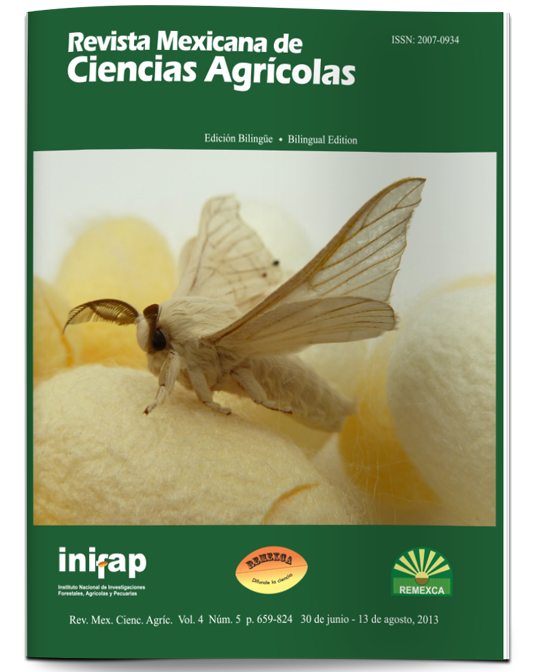Forage potential of four legume species in the summer cycle of the Laguna Region
DOI:
https://doi.org/10.29312/remexca.v4i5.1166Keywords:
chemical composition of forage, dry matter distribution, dry matter yield, nutrient yieldAbstract
An alternative to improve the quality of dairy cattle diets is the use of annual legumes. The aim of this study was to compare the nutritional composition and potential yields of dry matter (DM) and nutrients of four annual legume species available during the summer cycle in the Laguna Region. The experiment was established on July 05 and 08 of 2005 and 2006, respectively, in the Experimental Field La Laguna of the INIFAP located in Matamoros, Coahuila, Mexico. Two genotypes of cowpeas (Vigna unguiculata L.) were evaluated, one of pigeon pea (Cajanus cajan L.), four of soybean (Glycine max L.) and one of hyacinth bean (Lablab purpureus L.). The experimental design was a randomized complete block with four replicates. The yield of DM and the distribution of DM in the aerial part were determined, as well as the chemical composition of the forage. Soybean yields (7 757-9 280 kg ha-1) were higher (p≤ 0.05) than those of cowpea, pigeon pea and hyacinth bean (2 200-6 132 kg ha-1). The best results were obtained with Hutchinson soybean (p≤ 0.05) due to its high yields of DM, net energy for lactation (NEL) and crude protein (CP) per hectare, in addition to its good nutritional composition, measured in terms of CP content (228-242 g kg-1), NEL (1.48-1.58 Mcal kg-1 DM) and neutral detergent fiber (318- 335 g kg-1). The low allocation of DM to the stem and the precocity of this species led to a higher proportion of pods in the forage (p≤ 0.05), increasing the nutrient composition during the summer cycle.
Downloads
Downloads
Published
How to Cite
Issue
Section
License
The authors who publish in Revista Mexicana de Ciencias Agrícolas accept the following conditions:
In accordance with copyright laws, Revista Mexicana de Ciencias Agrícolas recognizes and respects the authors’ moral right and ownership of property rights which will be transferred to the journal for dissemination in open access. Invariably, all the authors have to sign a letter of transfer of property rights and of originality of the article to Instituto Nacional de Investigaciones Forestales, Agrícolas y Pecuarias (INIFAP) [National Institute of Forestry, Agricultural and Livestock Research]. The author(s) must pay a fee for the reception of articles before proceeding to editorial review.
All the texts published by Revista Mexicana de Ciencias Agrícolas —with no exception— are distributed under a Creative Commons License Attribution-NonCommercial 4.0 International (CC BY-NC 4.0), which allows third parties to use the publication as long as the work’s authorship and its first publication in this journal are mentioned.
The author(s) can enter into independent and additional contractual agreements for the nonexclusive distribution of the version of the article published in Revista Mexicana de Ciencias Agrícolas (for example include it into an institutional repository or publish it in a book) as long as it is clearly and explicitly indicated that the work was published for the first time in Revista Mexicana de Ciencias Agrícolas.
For all the above, the authors shall send the Letter-transfer of Property Rights for the first publication duly filled in and signed by the author(s). This form must be sent as a PDF file to: revista_atm@yahoo.com.mx; cienciasagricola@inifap.gob.mx; remexca2017@gmail.
This work is licensed under a Creative Commons Attribution-Noncommercial 4.0 International license.



